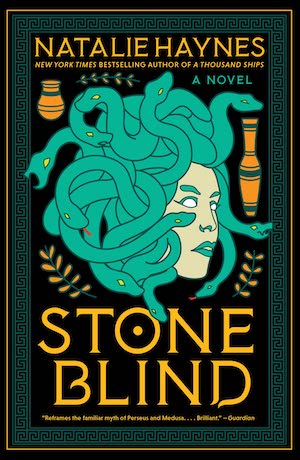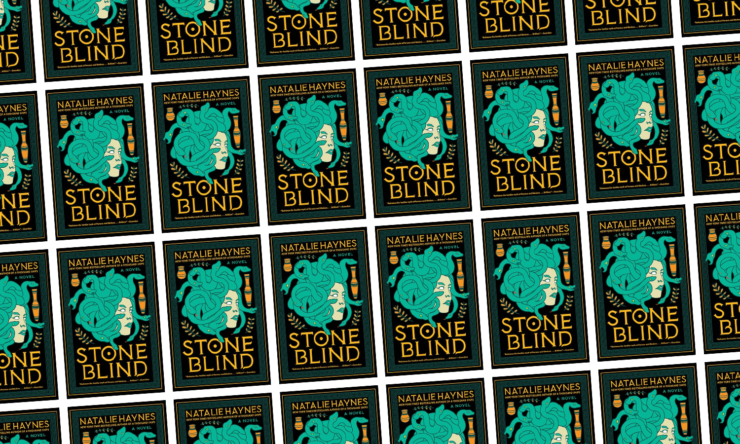Natalie Haynes is a comedian, writer, and broadcaster, and along with Professor Dame Mary Beard, is probably at the moment the UK’s most well-known female classicist. Stone Blind is her third novel to draw directly from the well of classical mythology, after A Thousand Ships and Jocasta’s Children, and in Stone Blind Haynes turns her gaze on Medusa, the mortal Gorgon, daughter of Phorcys and Ceto.
Like almost every figure of Greek mythology, what we know of Medusa (whose name is cognate with μέδω, a verb which means to protect or to rule over) comes down to us in tantalising asides and fragments from early antiquity or Classical tragedy, supplemented (or supplanted) by Roman-period reworkings. In popular culture, these sources are often confused—and rarely clarified—in the reinventions and reinterpretations of later centuries.
Buy the Book


Stone Blind
Φόρκυϊ δ᾽ αὖ Κητὼ Γραίας τέκε καλλιπαρῄους
ἐκ γενετῆς πολιάς, τὰς δὴ Γραίας καλέουσιν
ἀθάνατοί τε θεοὶ χαμαὶ ἐρχόμενοί τ᾽ ἄνθρωποι,
Πεμφρηδώ τ᾽ ἐύπεπλον Ἐνυώ τε κροκόπεπλον,
Γοργούς θ᾽, αἳ ναίουσι πέρην κλυτοῦ Ὠκεανοῖο
ἐσχατιῇ πρὸς Νυκτός, ἵν᾽ Ἑσπερίδες λιγύφωνοι,
Σθεννώ τ᾽ Εὐρυάλη τε Μέδουσά τε λυγρὰ παθοῦσα.
ἣ μὲν ἔην θνητή, αἳ δ᾽ ἀθάνατοι καὶ ἀγήρῳ,
αἱ δύο: τῇ δὲ μιῇ παρελέξατο Κυανοχαίτης
ἐν μαλακῷ λειμῶνι καὶ ἄνθεσιν εἰαρινοῖσιν.“And moreover to Phorkys, Keto bore the beautiful-cheeked Graiai [lit. old women], grey-haired from their birth, and indeed both deathless gods and mortals who come and go on the earth call them “Graiai”, well-gowned Pemphredo and yellow-gowned Enyo, and [she bore] the Gorgons as well, the ones who dwell beyond glorious Ocean in the furthest part towards Night, where the clear-voiced Hesperides [also dwell], Sthenno and Euryale and Medusa who suffered ruin. She was mortal, while they were deathless and unageing, the two of them: and the Dark-Haired One [Poseidon] lay with her in a soft meadow in the bloom of spring.”
–Hesiod, Theogony 270-278, my own translation.
Medusa’s story as we know it is encapsulated in a few lines of the Theogony, the earliest dateable work of Greek literature (late 8th-early 7th century BCE): her birth, her mortality, her intercourse with Poseidon, her death at the hands of Perseus, the afterlife of her severed head, and the children that sprang from her decapitated corpse. But her severed head, the Gorgoneion, may have earlier currency: it’s mentioned in the Homeric corpus, and it’s a common motif in art across the Greek world from at least the 8th century BCE, although its popularity in monumental architecture wanes after a couple of centuries: far fewer gorgoneia show up on religious buildings after the end of the 6th century BCE.
Aeschylus (mid 6th-mid 5th century BCE) describes Gorgons in Prometheus Bound as winged and snake-haired, and around the same time (c. 490BCE) Pindar (in his 12th Pythian Ode) also gives a potted history of the death of “fair-cheeked” (εὐπάραος) Medusa, in an explanation for Athena’s invention of the flute (which was, he says, inspired by the cries Medusa’s sisters made when they discovered her dead body).
And that is the most—not the last, but definitely the most—we hear of Medusa until Ovid tells the story of Perseus in the Metamorphoses in the early first century CE, where he adds that Medusa was violated by Neptune/Poseidon in the temple of Minerva/Athena, and that Athena punished Medusa by transforming her hair to snakes in consequence. Soon after Ovid’s Latin version, (Pseudo-)Apollodoros includes Perseus’ murder of Medusa in the Greek Library of Mythology, which is generally agreed to date from the 1st or early 2nd century CE.
Most modern novels that take a mythological figure for their centrepiece reinvent or reinterpret the myth, adding or subtracting to suit their argument and the conventions of the modern novel, which prefers a structure that’s rather different to ancient literature. Haynes, though. Haynes takes nothing that isn’t implied in the original sources, and subtracts very little: her retelling is a matter of emphasis and empathy, a filling-in of silences. A change in the angle of view.
As a novel it is, then, a peculiar sort of beast, for it has the structure of Greek myth: episodic, at times elliptical, where the strong and the clever are over-mastered by chance or nemesis, fate or the gods, or a stronger, cleverer opponent, and where a character’s ultimate end owes nothing at all to what a modern audience might think of as what they deserved.
The thing about Greek mythology is that it reflects a world defined by starkly hierarchical relations of power—slave and master, follower and lord, mortal and god, and let’s not forget to add the hierarchical gender division either—in which the most powerful men may act with impunity against those not protected either by another powerful man or by the aggregate power of social convention. And social convention permitted, or even encouraged, extremes of violence to be visited upon enemies, outsiders, and transgressors of custom or law.
The Greek gods, then, to us, are—ought to be—horrifying. So too the heroes and demigods, whether monstrous or beautiful of form. Their moral universe follows different rules than our own. In Stone Blind Haynes captures the essence of this difference by humanising the quintessentially monstrous Gorgons: Sthenno and Euryale, who find their mortal sister deposited on the shores they claimed as their own. In raising someone mortal and changeable they, too, change. They learn empathy for someone different to themselves. Medusa grows to adulthood, wanting to bring harm to none, and she too has empathy for mortals weaker than herself. Even raped and transformed—twice harmed by the gods—she still has no desire to cause suffering. The gods, in the background, do as they wish, proud and remorseless and full of self-love. Perseus, most-favoured mortal son of Zeus, offends a king who wants his mother for a wife, and agrees to bring home a Gorgon’s head.
Rape is a theme here. And arrogance, the willful blindness required to see tools and things and obstacles instead of people.
Haynes is a compelling writer and a very readable prose stylist. Her command of the mythological material allows her to weave disparate fragments together into a connected whole, and her sense of humour—sardonic, interested in juxtaposition and in puncturing inflated egos—shines through the entire book. Stone Blind is part argument with the classical construction of heroism, part commentary on the silences and absences of the classical mythological canon, and part a furious diatribe against Perseus. It’s piercing and poignant. And while I’m not entirely sure how well it works for a reader less familiar with the ancient Greek world, it’s an entertainingly ambitious project.
I enjoyed it.
Stone Blind is published by Harper.
Liz Bourke is a cranky queer person who reads books. She holds a Ph.D in Classics from Trinity College, Dublin. Her first book, Sleeping With Monsters, a collection of reviews and criticism, was published in 2017 by Aqueduct Press. It was a finalist for the 2018 Locus Awards and was nominated for a 2018 Hugo Award in Best Related Work. She was a finalist for the inaugural 2020 Ignyte Critic Award, and has also been a finalist for the BSFA nonfiction award. She lives in Ireland with an insomniac toddler, her wife, and their two very put-upon cats.










